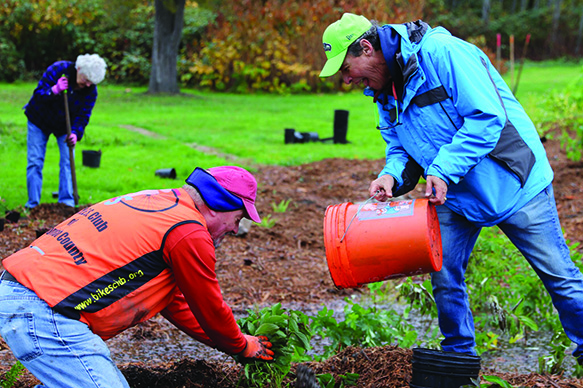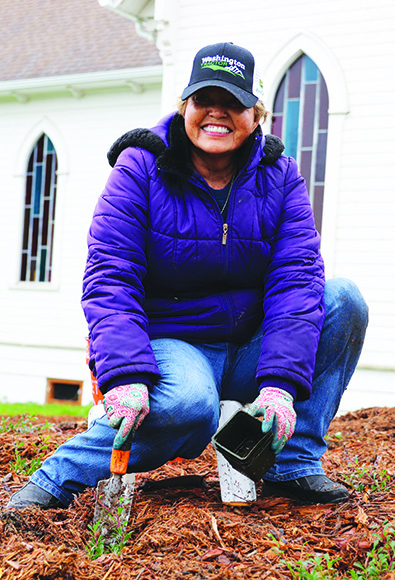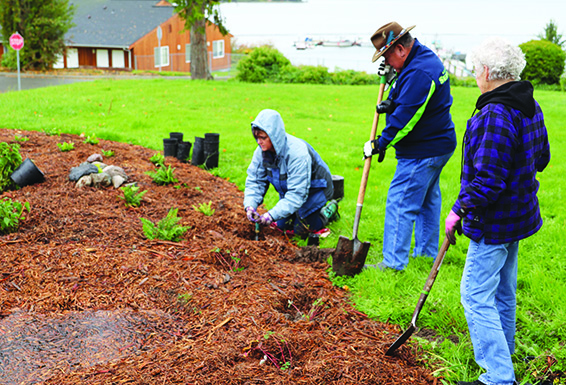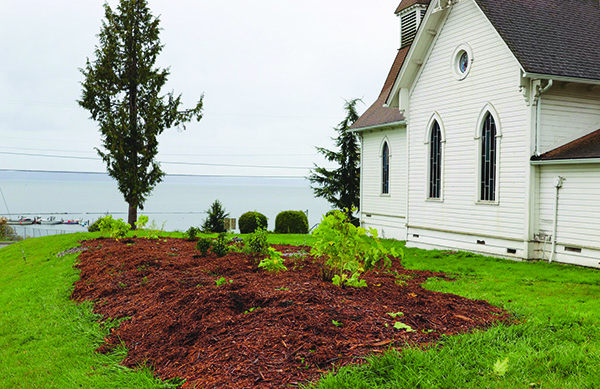
By Kalvin Valdillez, Tulalip News
“Being from Tulalip, my family always went to church here,” said Bill Topash, Tulalip Elder and St. Anne’s Roman Catholic Church member. “We have fond memories from when we were youngsters and I think it’s important to preserve this historical building. It was originally built in the 1890’s, it burned down and was rebuilt in 1905 and Catholic mass has been held here ever since.”
The white cathedral located across the street from the Tulalip Marina received a new landscape feature that will not only add to the property’s beautiful scenery, but will help address a number of issues St. Anne’s has been facing over recent years.
“We had a couple of engineering studies done about four, five years ago on the church,” Bill explained. “We found out the basement is in terrible disrepair. We were able to get some funding to get a clean crawl company to come out and clean it out, put a vapor barrier down there. But, we knew the terrible condition that the underside of the church was in, so our first significant step after the vapor barrier was trying to get the water to drain away from the church’s foundation.”

After brainstorming possible solutions, the church reached out to the Snohomish Conservation District for assistance. Upon learning about the church’s problematic flooding as well as its proximity to Tulalip Bay, the Conservation District took on the task of deterring storm water run-off and excessive water buildup away from the base of the building by constructing a rain garden on the side of the church.
A rain garden collects storm water runoff from rooftops, nearby streets, lawns and driveways, absorbing and filtering out harmful pollutants like oil, metal, paint, pesticide, fertilizer and garbage. According to the EPA, rain gardens effectively remove 90% of chemicals and 80% of sediments from storm water runoff, preventing those containments from entering our ecosystem.
“We’re really close to the bay, so pollutants that come off of roofs and paved surfaces go right into the bay,” said Derek Hann, Snohomish Conservation District Engineer. “We’re putting in a rain garden to take water from the roof of the Mission. This acts as a filter, so it does a really good job at removing all of those pollutants, it also helps with flooding issues.”
The Conservation District has worked on similar projects in the past and received funding from the Tulalip Charitable Foundation to build rain gardens. Familiar with the procedure, the Conservation District helped the church throughout process, assisting with the funding application, as well as following the Tulalip Tribes native plants and rain garden handbooks.

“I used the rain garden manual that was issued by the Tribal Restoration Committee, so all the plants here are native to the area and have some sort of cultural significance,” stated David Jackson, Snohomish Conservation Community Conservation Resource Specialist. “We have kinnikinnick, that’s been used traditionally for a long time by the Tribes. We also have common camas; they are a real beautiful dark purple-blue flower. We planted a lot of coastal strawberries and snowberries, those are going to attract a lot of animals to the area. The spirea and thimbleberries are going to be very good pollinators. They’re going to help biodiversity in the area. You don’t have to put much time and attention into maintaining them and you get to have community planting events and watch the garden grow over the years.”
On the morning of October 20, members of the church as well as the Snohomish Conservation District met to put the finishing touches on the garden. With a majority of the prep work done in the summertime, the crew dedicated just a couple hours to plant various native shrubs, trees and flowers in the newly established rain garden.
“We started the construction process in June and put the pipe and materials down and it’s been sitting here waiting for plants,” David said. “This is the last phase but the project will be ongoing as long as the rain garden is here. We cannot overstate how thankful and appreciative we are. The church and the Tribe worked with us through the entire construction process, all the volunteers are members of the church and of the community and it was a very special project for us.”

If you have any questions or you’re in need of assistance with a rain garden, David encourages you to call the Snohomish Conservation District at (425) 335-5634, stating they would be happy to help. Likewise, Bill invites you to check out the new St. Anne rain garden and learn about its function and about the native plants.
“From what I understand it is self-sustaining and low maintenance,” Bill said. “Our next goal is to have some sort of display explaining the purpose of the garden and the variety of the plants that are in there. These are all native plants. I noticed there was kinnikinnick and I said, ‘oh good, Indian tobacco.’ It’s nice to see that coming back again. We are very thankful to the Tribe, the Charitable Fund and the Snohomish Conservation District for helping us preserve our historical church. And we invite anybody to come out, everybody’s welcome.”
St. Anne’s Roman Catholic Church is now accepting donations for their annual holiday bazaar, held every Saturday from November 30 through December 23. All proceeds will go towards gifts for the homebound elders of the Tulalip community. For more information, please contact St. Anne’s at (360) 653-9400.